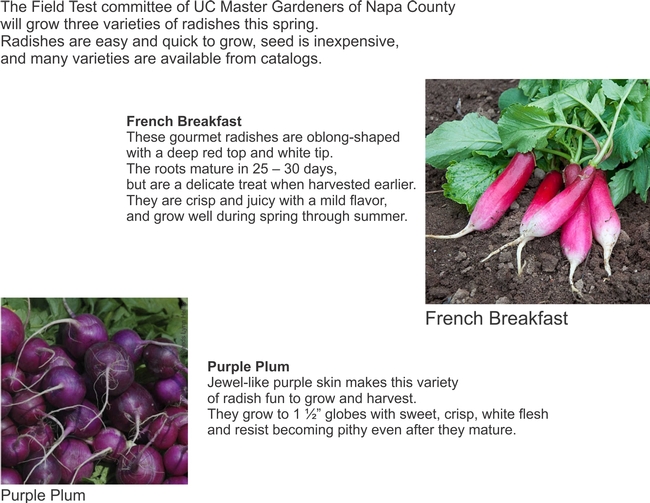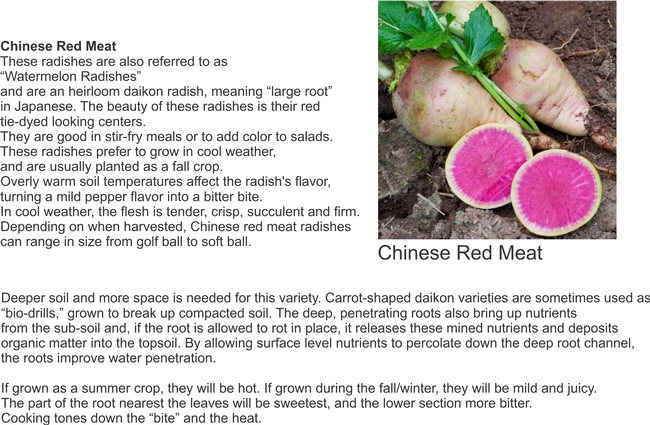Growing guidelines for radishes
Dig the soil to a depth of 6 inches for quick-growing radishes and up to 2 feet for large, sharper-tasting, slower-growing winter types. Space seeds ½ inch deep and 1 inch apart; firm the soil and water gently. Thin seedlings to 2 inches apart, 3 to 6 inches for the larger winter types and mulch to keep down weeds. For quick growth and the best flavor, water regularly. Make weekly spring sowings as soon as you can work the soil (4 to 6 weeks before the last expected frost) until early summer; start again in late summer. Sow winter radishes in midsummer for a fall harvest.
Spring radishes should be planted from as early as the soil can be worked until mid-spring. Make successive plantings of short rows every 10 to 14 days. Plant in spaces between slow-maturing vegetables (such as broccoli and brussels sprouts) or in areas that will be used later for warm-season crops (peppers, tomatoes and squash). Spring radishes also can be planted in late winter in a protected cold frame, window box or container in the house or on the patio. Later-maturing varieties of radishes (Icicle or French Breakfast ) usually withstand heat better than the early maturing varieties and are recommended for late-spring planting for summer harvest. Winter radishes require a much longer time to mature than spring radishes and are planted at the same time as late turnips (usually midsummer to late summer).
Spacing & Depth - Sow seed 1/4 to 1/2 inch deep. Thin spring varieties to 1/2 to 1 inch between plants. Winter radishes must be thinned to 2 to 4 inches, or even farther apart to allow for proper development of their larger roots. On beds, radishes may be broadcast lightly and thinned to stand 2 to 3 inches apart in all directions.
Care - Radishes grow well in almost any soil that is prepared well, is fertilized before planting and has adequate moisture maintained. Slow development makes radishes hot in taste and woody in texture.
Radishes mature rapidly under favorable conditions and should be checked often for approaching maturity. Harvest should begin as soon as roots reach edible size and should be completed quickly, before heat, pithiness or seedstalks can begin to develop.
Harvesting - Pull radishes when they are of usable size (usually staring when roots are less than 1 inch in diameter) and relatively young. Radishes remain in edible condition for only a short time before they become pithy (spongy) and hot. Proper thinning focuses the harvest and avoids disappointing stragglers that have taken too long to develop.
Winter varieties mature more slowly and should be harvested at considerably larger size. Once they reach maturity, they maintain high quality for a fairly long time in the garden, especially in cool fall weather. Size continues to increase under favorable fall conditions. Daikon or Chinese radish, can achieve particularly large size and still maintain excellent quality. Winter radishes can be pulled before the ground freezes and stored in moist cold storage for up to several months.
Questions & Answers
Q. What causes my radishes to crack and split?
A. The radishes are too old. Pull them when they are younger and smaller. A flush of moisture after a period of relative dryness also may cause mature roots to burst and split. Try to avoid uneven moisture availability.
Q. Why do my radishes grow all tops with no root development?
A. There may be several reasons: seed planted too thickly and plants not thinned (though some roots along the outside of the row usually develop fairly well even under extreme crowding), weather too hot for the spring varieties that do best in cool temperatures (planted too late or unseasonable weather) and too much shade (must be really severe to completely discourage root enlargement).
Q. What causes my radishes to be too "hot"?
A. The "hotness" of radishes results from the length of time they have grown rather than from their size. The radishes either grew too slowly or are too old.
Selection & Storage
Summer Radish - Radishes have often been dismissed as decoration and garnish. They are actually members of the cruciferous vegetable family so eat the greens. Because they vary in keeping quality, radishes are classified as winter or summer. Summer radishes are the small ones of bold red, pink, purple, white or red and white. They may be globe-shaped or elongated, fiery hot or mild. Harvest summer radishes when they are small and tender for optimal flavor. Oversize summer radishes can become tough, woody, hallow and strong in flavor. To check a large radish squeeze gently, if it yields to pressure it is likely to be fibrous. These will do well in the compost heap.
Winter Radish - Harvest winter radishes when they are large and mature. Winter radishes may be white, black or green. Black radishes have a pungent flavor and should be used sparingly. Remove greens and roots before storing black radishes. Chinese radishes, round and fat, are milder in flavor. Remove greens before storing; remove roots just before preparing. The word daikon means "great root" in Japanese. In cool weather, daikon growth is quick and steady. The fully mature daikon can grow up to about 18 inches long and weighs 5 or 6 pounds. There are several varieties. Some are thin and long, while others are short and round. All radish greens are edible.
Save the young thinnings of both summer and winter radishes. They are delicious with tops and bottoms intact. Both summer and winter radishes store well in the refrigerator once the tops have been removed. The radish leaves cause moisture and nutrient loss during storage. Store greens separately for 2-3 days. Refrigerate radishes wrapped in plastic bags for 5 to 7 days. Winter radish varieties can be stored for up to two weeks in the refrigerator.
Nutritional Value & Health Benefits
The popular red globe radish is low in calories with an abundance of flavor and crunch. A 1/2 cup serving (about 12 medium) of sliced radishes provides a goodly amount of potassium, vitamin C, folate and fiber. Winter radishes such as daikons are similar in nutrients.
Nutrition Facts (1/2 cup fresh sliced raw red globes)
Calories 12
Protein 0.35 grams
Carbohydrates 2.0 grams
Dietary Fiber 1 gram
Potassium 134.56 mg
Folate 15.66 mcg
http://postharvest.ucdavis.edu/pfvegetable/Radish/
http://ucanr.edu/sites/scmg/The_Kitchen_Garden/Feature_Vegetables/Daikon/

